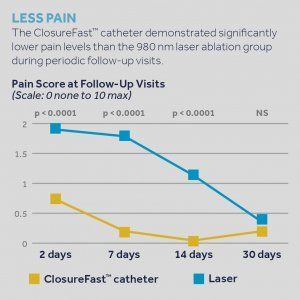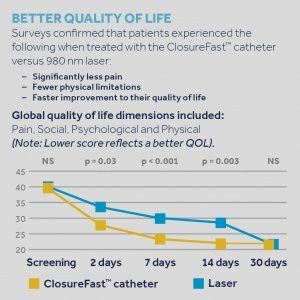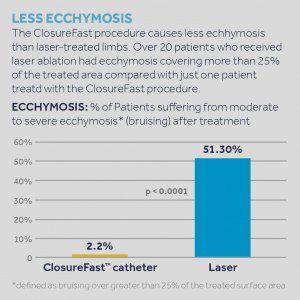Supporting copy for the Request Service
call out button.
Varicose Vein Ablation
Excellent Varicose Vein Ablation Procedures
About The ClosureFast™ Procedure
The ClosureFast™ procedure uses radiofrequency energy to precisely and effectively treat patients suffering from Chronic Venous Insufficiency (CVI).
- The ClosureFast™ catheter precisely heats a 7 cm vein segment (or 3 cm for shorter, refluxing vein lengths) in one 20-second interval.
- The system’s controlled feedback mechanism monitors intravascular heat parameters in real time to automatically regulate therapeutic power.
- The heat provided by the catheter shrinks and collapses the target vein, creating a fibrotic seal and occluding the vessel.
Minimally Invasive
The ClosureFast™ procedure eliminates the need for groin surgery and general anesthesia and is generally performed using local anesthesia in a vein specialist’s office or an outpatient surgical facility. The procedure takes approximately 45-60 minutes and most patients typically spend two to three hours at the medical facility due to normal pre- and post-treatment procedures.
Less Pain, Less Bruising, Faster Recovery
Studies show that the ClosureFast™ procedure is associated with lower rates of pain, bruising, and complications and a faster improvement in patients’ quality of life when compared to 980 nm laser ablation. The average patient typically resumes normal activities within a few days following treatment.

Clinical Outcomes
A prospective, international, multi-center study showed that 91.9% of treated veins were closed in 5 years following treatment with the ClosureFast™ procedure.(3,4) The study used the Kaplan Meier analysis, a common statistic used for a variety of endpoints, including the effectiveness of a treatment over a defined period of time.
References:
1. Almeida JI, Kaufman J, Goekeritz O, et al. Radiofrequency Endovenous ClosureFAST versus Laser Ablation for the Treatment of Great Saphenous Reflux: A Multicenter, Single-Blinded, Randomized Study (Recovery Study). JVIR June 2009.
2. L.H. Rasmussen, M. Lawaetz, L. et al, Randomized Clinical Trial Comparing Endovenous Laser Ablation, Radiofrequency Ablation, Foam Sclerotherapy and Surgical Stripping for Great Saphenous Varicose Veins. British Journal of Surgery Society Ltd., Wiley Online Library, www.bjs.co.uk, March 15, 2011.
3. Proebstle TM, Alm BJ, Gockeritz O et al. Five-year results from the prospective European multicentre cohort study on radiofrequency segmental thermal ablation for incompetent great saphenous veins. British Journal of Surgery. 2015;102:212-8.

Clinical and Lifestyle Benefits
Faster Recovery:
Patients treated with the ClosureFast™ Procedure may resume normal activities more quickly than patients who undergo surgical vein stripping or 980 nm laser ablation (see charts below). With the ClosureFast™ Procedure, the average patient typically resumes normal activities within a few days.(1) For a few weeks following the treatment, your vein specialist may recommend a regular walking regimen and suggest you refrain from very strenuous activities (heavy lifting, for example) or prolonged periods of standing.
Potential Risks:
As with all medical procedures, there is a chance that complications may occur, including, but not limited to the following:
- Hematoma
- Vessel perforation
- Thrombosis
- Pulmonary embolism
- Phlebitis
- Infection
- Adjacent nerve injury
- Skin burn or discoloration
To locate a vein specialist in your area, visit our find a doctor physician locator.
References:
1. L.H. Rasmussen, M. Lawaetz, L. et al, Randomized Clinical Trial Comparing Endovenous Laser Ablation, Radiofrequency Ablation, Foam Sclerotherapy and Surgical Stripping for Great Saphenous Varicose Veins. British Journal of Surgery Society Ltd., Wiley Online Library, www.bjs.co.uk, March 15, 2011.
†Individual results may vary. Photo courtesy of the Vein Institute of the North Shore, Beverly, MA. This picture shows results of the ClosureFastTM Procedure treatment only. Cosmetic improvements may come sooner with adjunctive procedures. Results of ‘after’ picture is shown 3 months post procedure.
4. Proebstle T, Alm J, Gockeritz O, et al. Three year European follow-up endovenous radiofrequency thermal ablation of the great saphenous vein with or without treatment of calf varicosities. J Vasc Surg. 2011;54(1)146-52.
*For 7cm RF catheter.
Call us to schedule an appointment with us.
334-387-0948
Most patients report a noticeable improvement in their symptoms within 1-2 weeks following the ClosureFast™ Procedure. Most patients report limited to no scarring, bruising (ecchymosis), or swelling following the ClosureFast™ Procedure. Contact River Region Cardiology today!



334-387-0948
About Us
A cardiovascular condition or disease needs immediate attention from world-class physicians. When your doctor needs to conclude what your condition is, accurate tests and echocardiography are key.
Depend on River Region Cardiology to provide you with advanced imaging, testing, and treatments. Call us to schedule an appointment today!
Contact Us Now
River Region Cardiology
Fax: 334-387-0955
185 Mitylene Park Lane
Montgomery, Alabama 36117
Tel:
334-387-0948
Montgomery, Alabama 36117
Fax: 334-387-0955
Privacy Policy
| Do Not Share My Information
| Conditions of Use
| Notice and Take Down Policy
| Website Accessibility Policy
© 2025
The content on this website is owned by us and our licensors. Do not copy any content (including images) without our consent.
